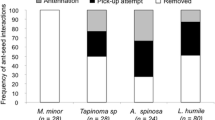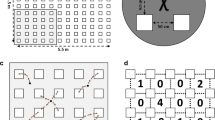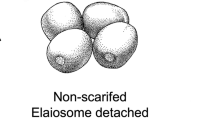Abstract
Plant–animal mutualisms, such as seed dispersal, are often vulnerable to disruption by invasive species. Here, we show for the first time how a non-ant invasive species negatively affects seed dispersal by ants. We examined the effects of several animal species that co-occur in a temperate deciduous forest—including native and invasive seed-dispersing ants (Aphaenogaster rudis and Myrmica rubra, respectively), an invasive slug (Arion subfuscus), and native rodents—on a native myrmecochorous plant, Asarum canadense. We experimentally manipulated ant, slug, and rodent access to seed depots and measured seed removal. We also video-recorded depots to determine which other taxa interact with seeds. We found that A. rudis was the main disperser of seeds and that A. subfuscus consumed elaiosomes without dispersing seeds. Rodent visitation was rare, and rodent exclusion had no significant effect on seed or elaiosome removal. We then used data obtained from laboratory and field mesocosm experiments to determine how elaiosome robbing by A. subfuscus affects seed dispersal by A. rudis and M. rubra. We found that elaiosome robbing by slugs reduced seed dispersal by ants, especially in mesocosms with A. rudis, which picks up seeds more slowly than M. rubra. Taken together, our results show that elaiosome robbing by an invasive slug reduces seed dispersal by ants, suggesting that invasive slugs can have profound negative effects on seed dispersal mutualisms.



Similar content being viewed by others
References
Barr NB, Cook A, Elder P et al (2009) Application of a DNA barcode using the 16S rRNA gene to diagnose pest Arion species in the USA. J Molluscan Stud 75:187–191
Beattie A, Culver D (1981) The guild of myrmecochores in the herbaceous flora of West Virginia forests. Ecology 62:107–115
Beaumont KP, Mackay D, Whalen M (2011) Interactions between ants and seeds of two myrmecochorous plant species in recently burnt and long-unburnt forest sites. Austral Ecol 36:767–778. doi:10.1111/j.1442-9993.2010.02215.x
Beyer W, Saari D (1978) Activity and ecological distribution of the slug, Arion subfuscus (Draparnaud) (Stylommatophora, Arionidae). Am Midl Nat 100:359–367
Blattmann T, Boch S, Türke M, Knop E (2013) Gastropod seed dispersal: an invasive slug destroys far more seeds in its gut than native gastropods. PLoS ONE 8:e75243. doi:10.1371/journal.pone.0075243
Bond AW, Slingsby P (1984) Collapse of an ant-plant mutalism: the argentine ant (Iridomyrmex Humilis) and myrmecochorous Proteaceae. Ecology 65:1031–1037
Boulay R, Carro F, Soriguer RC, Cerdá X (2009) Small-scale indirect effects determine the outcome of a tripartite plant–disperser–granivore interaction. Oecologia 161:529–537. doi:10.1007/s00442-009-1404-z
Boyd RS (2001) Ecological benefits of myrmecochory for the endangered chaparral shrub Fremontodendron decumbens (Sterculiacae). Am J Bot 88:234–241
Calvino-Cancela M, Rubido-Bará M (2012) Effects of seed passage through slugs on germination. Plant Ecol 213:663–673. doi:10.1007/s11258-012-0030-8
Cardina J, Norquay H, Stinner B, McCartney D (1996) Postdispersal predation of velvetleaf (Abutilon theophrasti) seeds. Weed Sci 44:534–539
Carney SE, Byerley MB, Holway D (2003) Invasive Argentine ants (Linepithema humile) do not replace native ants as seed dispersers of Dendromecon rigida (Papaveraceae) in California, USA. Oecologia 135:576–582. doi:10.1007/s00442-003-1200-0
Chichester L, Getz L (1973) The terrestrial slugs of northeastern North America. Sterkiana 51:11–42
Chlumsky J, Koutecky P, Jilkova V, Stech M (2012) Roles of species-preferential seed dispersal by ants and endozoochory in Melampyrum (Orobanchaceae). J Plant Ecol 6:232–239. doi:10.1093/jpe/rts039
Christian C (2001) Consequences of a biological invasion reveal the importance of mutualism for plant communities. Nature 413:635–639
Christian CE, Stanton ML (2004) Cryptic consequences of a dispersal mutualism: seed burial, elaiosome removal, and seed-bank dynamics. Ecology 85:1101–1110
Cowie RH, Robinson DG (2003) Pathways of introduction of nonindigenous land and freshwater snails and slugs. In: Ruiz GM, Carlton JT (eds) Invasive species vectors and management strategies. Island Press, Washington DC, pp 93–122
Dussutour A, Simpson SJ (2008) Description of a simple synthetic diet for studying nutritional responses in ants. Insectes Soc 55:329–333. doi:10.1007/s00040-008-1008-3
Fokuhl G, Heinze J, Poschlod P (2007) Colony growth in Myrmica rubra with supplementation of myrmecochorous seeds. Ecol Res 22:845–847. doi:10.1007/s11284-006-0331-2
Fritz R, Hochwender C, Lewkiewicz D et al (2001) Seedling herbivory by slugs in a willow hybrid system: developmental changes in damage, chemical defense, and plant performance. Oecologia 129:87–97. doi:10.1007/s004420100703
Gibson W (1993) Selective advantages to hemi-parasitic annuals, genus Melampyrum, of a seed-dispersal mutualism involving ants: I. favorable nest sites. Oikos 67:334–344
Giladi I (2006) Choosing benefits or partners: a review of the evidence for the evolution of myrmecochory. Oikos 112:481–492
Gorb S, Gorb E (1999) Effects of ant species composition on seed removal in deciduous forest in eastern Europe. Oikos 84:110–118
Gorb E, Gorb S (2003) Seed dispersal by ants in a deciduous forest ecosystem. Springer SBM, Berlin, pp 136–141
Groden E, Drummond FA, Garnas J, Franceour A (2005) Distribution of an invasive ant, Myrmica rubra (Hymenoptera : Formicidae), in Maine. J Econ Entomol 98:1774–1784
Gunther RW, Lanza J (1989) Variation in attractiveness of Trillium diaspores to a seed-dispersing ant. Am Midl Nat 122:321–328
Hahn PG, Draney ML, Dornbush ME (2011) Exotic slugs pose a previously unrecognized threat to the herbaceous layer in a midwestern woodland. Restor Ecol 19:786–794. doi:10.1111/j.1526-100X.2010.00710.x
Handel S, Fisch S, Schatz G (1981) Ants disperse a majority of herbs in a mesic forest community in New York state. Bull Torrey Bot Club 108:430–437
Heithaus E (1981) Seed predation by rodents on three ant-dispersed plants. Ecology 62:136–145
Horvitz CC, Schemske DW (1986) Seed dispersal of a tropical myrmecochore: variation in removal rates and dispersal distance. Biotropica 18:319–323
Irwin RE, Bronstein JL, Manson JS, Richardson L (2010) Nectar robbing: ecological and evolutionary perspectives. Annu Rev Ecol Evol Syst 41:271–292. doi:10.1146/annurev.ecolsys.110308.120330
Joe SM, Daehler CC (2007) Invasive slugs as under-appreciated obstacles to rare plant restoration: evidence from the Hawaiian Islands. Biol Invasions 10:245–255. doi:10.1007/s10530-007-9126-9
Jules ES (1996) Yellow jackets (Vespula vulgaris) as a second seed disperser for the myrmecochorous plant, Trillium ovatum. Am Midl Nat 135:367–369
Junker RR, Daehler CC, Stefan D et al (2011) Hawaiian ant-flower networks: nectar-thieving ants prefer undefended native over introduced plants with floral defenses. Ecol Monogr 81:295–311. doi:10.1890/10-1367.1
Kalisz S, Hanzawa F, Tonsor S et al (1999) Ant-mediated seed dispersal alters pattern of relatedness in a population of Trillium grandiflorum. Ecology 80:2620–2634
Kjellsson G (1991) Seed fate in an ant-dispersed sedge, Carex pilulifera L.: recruitment and seedling survival in tests of models for spatial dispersion. Oecologia 88:435–443. doi:10.1007/BF00317590
Lengyel S, Gove AD, Latimer AM et al (2009) Ants sow the seeds of global diversification in flowering plants. PLoS ONE 4:e5480. doi:10.1371/journal.pone.0005480
Lubertazzi D (2012) The biology and natural history of Aphaenogaster rudis. Psyche 2012:1–11. doi:10.1155/2012/752815
Maloof JE, Inouye DW (2000) Are nectar robbers cheaters or mutualists? Ecology 81:2651–2661. doi:10.1890/0012-9658(2000)081[2651:ANRCOM]2.0.CO;2
Mesler M, Lu K (1983) Seed dispersal of Trillium ovatum (Liliaceae) in second-growth redwood forests. Am J Bot 70:1460–1467
Morris WF (1996) Mutualism denied? Nectar-robbing bumble bees do not reduce female or male success of bluebells. Ecology 77:1451–1462
Muir A (1997) Seed predation and dispersal in a deciduous forest understory herb, wild ginger (Asarum canadense). MSc thesis. Department of Biology, Carlton University, Ottawa
Ness JH (2004) Forest edges and fire ants alter the seed shadow of an ant-dispersed plant. Oecologia 138:448–454. doi:10.1007/s00442-003-1440-z
Ness JH, Morin DF, Giladi I (2009) Uncommon specialization in a mutualism between a temperate herbaceous plant guild and an ant: are Aphaenogaster ants keystone mutualists? Oikos 118:1793–1804. doi:10.1111/j.1600-0706.2009.17430.x
O’Dowd D, Hay M (1980) Mutualism between harvester ants and a desert ephemeral: seed escape from rodents. Ecology 61:531–540
Ohara M, Higashi S (1987) Interference by ground beetles with the dispersal by ants of seeds of Trillium species (Liliaceae). J Ecol 75:1091–1098
Ohkawara K, Higashi S, Ohara M (1996) Effects of ants, ground beetles and the seed-fall patterns on myrmecochory of Erythronium japonicum Decne. (Liliaceae). Oecologia 106:500–506
Pinceel J, Jordaens K, Van Houtte N et al (2004) Molecular and morphological data reveal cryptic taxonomic diversity in the terrestrial slug complex Arion subfuscus/fuscus (Mollusca, Pulmonata, Arionidae) in continental north‐west Europe. Biol J Linn Soc 83:23–38
Pinceel J, Jordaens K, Van Houtte N et al (2005) Population genetics and identity of an introduced terrestrial slug: Arion subfuscus s.l. in the North-East USA (Gastropoda, Pulmonata, Arionidae). Genetica 125:155–171. doi:10.1007/s10709-005-5816-3
Prior KM, Saxena K, Frederickson ME (2014) Seed handling behaviours of native and invasive seed-dispersing ants differentially influence seedling emergence in an introduced plant. Ecol Entomol 39:66–74. doi:10.1111/een.12068
Prior KM, Robinson JM, Meadley Dunphy SA, Frederickson ME (2015) Mutualism between co-introduced species facilitates invasion and alters plant community structure. Proc Biol Sci. doi:10.1098/rspb.2014.2846
Riginos C, Karande M, Rubenstein D, Palmer TM (2015) Disruption of a protective ant—plant mutualism by an invasive ant increases elephant damage to savannah trees. Ecology 96:654–661
Rodriguez-Cabal Ma, Stuble KL, Guénard B et al (2011) Disruption of ant-seed dispersal mutualisms by the invasive Asian needle ant (Pachycondyla chinensis). Biol Invasions 14:557–565. doi:10.1007/s10530-011-0097-5
Servigne P, Detrain C (2010) Opening myrmecochory’s black box: What happens inside the ant nest? Ecol Res 25:663–672. doi:10.1007/s11284-010-0700-8
Smith B, Forman P, Boyd A (1989) Spatial patterns of seed dispersal and predation of two myrmecochorous forest herbs. Ecology 70:1649–1656
Traveset A, Richardson DM (2006) Biological invasions as disruptors of plant reproductive mutualisms. Trends Ecol Evol 21:208–216. doi:10.1016/j.tree.2006.01.006
Traveset A, Richardson DM (2014) Mutualistic interactions and biological invasions. Annu Rev Ecol Evol Syst 45:89–113. doi:10.1146/annurev-ecolsys-120213-091857
Traveset A, Riera N (2005) Disruption of a plant-lizard seed dispersal system and its ecological effects on a threatened endemic plant in the Balearic Islands. Conserv Biol 19:421–431. doi:10.1111/j.1523-1739.2005.00019.x
Türke M, Weisser W (2013) Species, diaspore volume and body mass matter in gastropod seed feeding behavior. PLoS ONE. doi:10.1371/journal.pone.0068788
Türke M, Heinze E, Andreas K et al (2010) Seed consumption and dispersal of ant-dispersed plants by slugs. Oecologia 163:681–693. doi:10.1007/s00442-010-1612-6
Türke M, Andreas K, Gossner MM et al (2012) Are gastropods, rather than ants, important dispersers of seeds of myrmecochorous forest herbs? Am Nat 179:124–131. doi:10.1086/663195
Turner KM, Frederickson ME (2013) Signals can trump rewards in attracting seed-dispersing ants. PLoS ONE 8:e71871. doi:10.1371/journal.pone.0071871
Umphrey G (1996) Morphometric discrimination among sibling species in the fulva-rudis-texana complex of the ant genus Aphaenogaster (Hymenoptera: Formicidae). Can J Zool 74:528–559
Warren RJ, McAfee P, Bahn V (2011) Ecological differentiation among key plant mutualists from a cryptic ant guild. Insectes Soc 58:505–512. doi:10.1007/s00040-011-0174-x
Warren RJ, McMillan A, King JR et al (2015) Forest invader replaces predation but not dispersal services by a keystone species. Biol Invasions 17:3153–3162. doi:10.1007/s10530-015-0942-z
Zelikova TJ, Dunn RR, Sanders NJ (2008) Variation in seed dispersal along an elevational gradient in Great Smoky Mountains National Park. Acta Oecol 34:155–162. doi:10.1016/j.actao.2008.05.002
Zettler Ja, Spira TP, Allen CR (2001a) Yellow jackets (Vespula spp.) disperse Trillium (spp.) seeds in Eastern North America. Am Midl Nat 146:444–446
Zettler JA, Spira TP, Allen CR (2001b) Ant-seed mutualisms: Can red imported fire ants sour the relationship? Biol Conserv 101:249–253. doi:10.1016/S0006-3207(01)00074-X
Acknowledgments
We are grateful for the help in the field provided by G. Cho, N. Macalasdair, T. H. Q. Powell, and S. Khadar. We thank A. Weis, J. Stinchcombe, S. Schneider, and other staff for providing support at Koffler Scientific Reserve at Joker’s Hill. Comments from two anonymous reviewers improved this manuscript. We acknowledge funding from NSERC’s Discovery Grant and Undergraduate Student Research Award programs, the Ontario Ministry of Economic Development and Innovation, and the University of Toronto.
Author contribution statement
SAMD, KMP, and MEF conceived and designed the experiments. SAMD and KMP implemented the experiments. SAMD, KMP, and MEF analyzed the data and wrote the manuscript.
Author information
Authors and Affiliations
Corresponding author
Additional information
Communicated by Ian Kaplan.
Electronic supplementary material
Below is the link to the electronic supplementary material.
Supplementary material 2 (MPG 3973 kb)
Supplementary material 3 (MPG 5867 kb)
Supplementary material 4 (MPG 1585 kb)
Rights and permissions
About this article
Cite this article
Meadley Dunphy, S.A., Prior, K.M. & Frederickson, M.E. An invasive slug exploits an ant-seed dispersal mutualism. Oecologia 181, 149–159 (2016). https://doi.org/10.1007/s00442-015-3530-0
Received:
Accepted:
Published:
Issue Date:
DOI: https://doi.org/10.1007/s00442-015-3530-0




